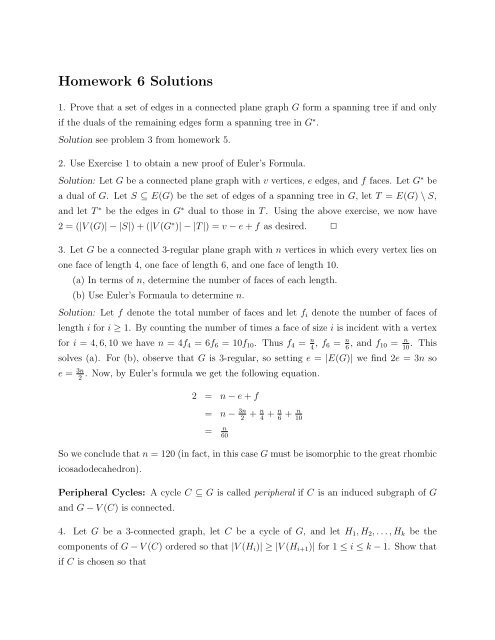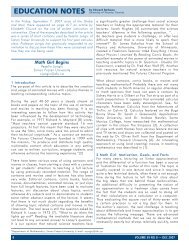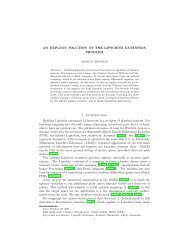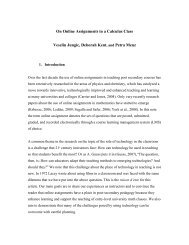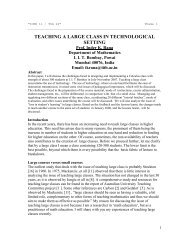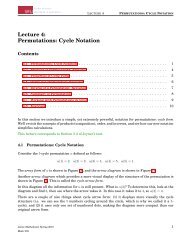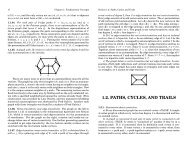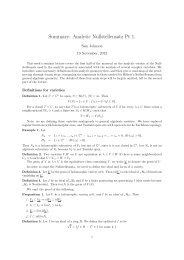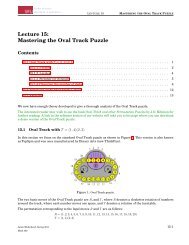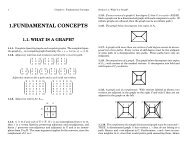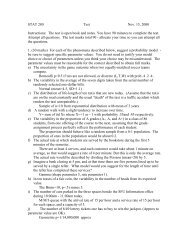Homework 6 Solutions - People.stat.sfu.ca
Homework 6 Solutions - People.stat.sfu.ca
Homework 6 Solutions - People.stat.sfu.ca
You also want an ePaper? Increase the reach of your titles
YUMPU automatically turns print PDFs into web optimized ePapers that Google loves.
<strong>Homework</strong> 6 <strong>Solutions</strong><br />
1. Prove that a set of edges in a connected plane graph G form a spanning tree if and only<br />
if the duals of the remaining edges form a spanning tree in G ∗ .<br />
Solution see problem 3 from homework 5.<br />
2. Use Exercise 1 to obtain a new proof of Euler’s Formula.<br />
Solution: Let G be a connected plane graph with v vertices, e edges, and f faces. Let G ∗ be<br />
a dual of G. Let S ⊆ E(G) be the set of edges of a spanning tree in G, let T = E(G) \ S,<br />
and let T ∗ be the edges in G ∗ dual to those in T . Using the above exercise, we now have<br />
2 = (|V (G)| − |S|) + (|V (G ∗ )| − |T |) = v − e + f as desired. ✷<br />
3. Let G be a connected 3-regular plane graph with n vertices in which every vertex lies on<br />
one face of length 4, one face of length 6, and one face of length 10.<br />
(a) In terms of n, determine the number of faces of each length.<br />
(b) Use Euler’s Formaula to determine n.<br />
Solution: Let f denote the total number of faces and let fi denote the number of faces of<br />
length i for i ≥ 1. By counting the number of times a face of size i is incident with a vertex<br />
for i = 4, 6, 10 we have n = 4f4 = 6f6 = 10f10. Thus f4 = n<br />
4 , f6 = n<br />
6 , and f10 = n . This<br />
10<br />
solves (a). For (b), observe that G is 3-regular, so setting e = |E(G)| we find 2e = 3n so<br />
e = 3n.<br />
Now, by Euler’s formula we get the following equation.<br />
2<br />
2 = n − e + f<br />
= n − 3n<br />
2<br />
= n<br />
60<br />
n n n<br />
+ + + 4 6 10<br />
So we conclude that n = 120 (in fact, in this <strong>ca</strong>se G must be isomorphic to the great rhombic<br />
icosadode<strong>ca</strong>hedron).<br />
Peripheral Cycles: A cycle C ⊆ G is <strong>ca</strong>lled peripheral if C is an induced subgraph of G<br />
and G − V (C) is connected.<br />
4. Let G be a 3-connected graph, let C be a cycle of G, and let H1, H2, . . . , Hk be the<br />
components of G − V (C) ordered so that |V (Hi)| ≥ |V (Hi+1)| for 1 ≤ i ≤ k − 1. Show that<br />
if C is chosen so that
(i) |V (H1)| is maximum<br />
(ii) |V (H2)| is maximum subject to (i)<br />
(iii) |V (H3)| is maximum subject to (i) and (ii)<br />
.<br />
then the cycle C is peripheral. (Hint: consider Hk)<br />
Solution: We shall prove a slightly stronger result with a very similar argument. Namely, we<br />
prove that for every edge e and every vertex x not incident with e, there exists a peripheral<br />
cycle which contains e and does not contain x. Note that this implies the existence of at<br />
least two peripheral cycles through every edge. Let C be a cycle which contains the edge<br />
e and does not contain x (one must exist by 3-connectivity) and order the components<br />
H0, H1, H2, . . . , Hk so that x ∈ V (H0) and |V (Hi)| ≥ |V (Hi+1| for 1 ≤ i ≤ k − 1. Suppose<br />
further that C is chosen so that<br />
(i) |V (H0)| is maximum<br />
(ii) |V (H1)| is maximum (subject to (i))<br />
.<br />
We claim that C is peripheral. If C is not an induced subgraph, then there is a cycle<br />
with fewer vertices in G[V (C)] containing e and this contradicts our choice. Thus, C is an<br />
induced subgraph. Suppose (for a contradiction) that k ≥ 1 and consider the component<br />
Hk. Let y, y ′ ∈ V (C) be the two vertices closest to e on the cycle in the clockwise and<br />
counterclockwise directions, and let P ⊆ C be the path of C from y to y ′ which does not<br />
contain e, and let P ′ ⊆ C be the path from y to y ′ which does contain e. It follows from<br />
our connectivity that y = y ′ . Further, there must exist a component Hj with j < k which<br />
contains a vertex adjacent to a point in the interior of the path P , since otherwise {y, y ′ } is a<br />
cutset. Now, we may choose a path Q from y to y ′ with all interior vertices in Hk. Replacing<br />
C by the cycle P ′ ∪ Q now gives us a contradiction, since the size of the component Hj will<br />
increase. Thus, k = 0 and C is peripheral.<br />
5. A slight extension of the previous exercise shows that for every 3-connected graph G and<br />
every edge e ∈ E(G), there exist at least two peripheral cycles containing e. Observe that if<br />
G is planar, there must be exactly two peripheral cycles containing e. Use this fact to prove<br />
that any two duals of a 3-connected planar graph are isomorphic.<br />
Solution Since every cycle in a plane graph separates the plane, every peripheral cycle in a<br />
2
plane graph must be the boundary of a face. It follows that every planar graph has ≤ 2<br />
peripheral cycles through any given edge. Combining this with the previous problem, we find<br />
that for a 3-connected planar graph G, every edge of G is contained in exactly two peripheral<br />
cycles. Thus, for any drawing of G in the plane, the boundaries of the faces must be exactly<br />
the peripheral cycles. We conclude that any two graphs which are dual to drawings of G<br />
must be isomorphic.<br />
3


